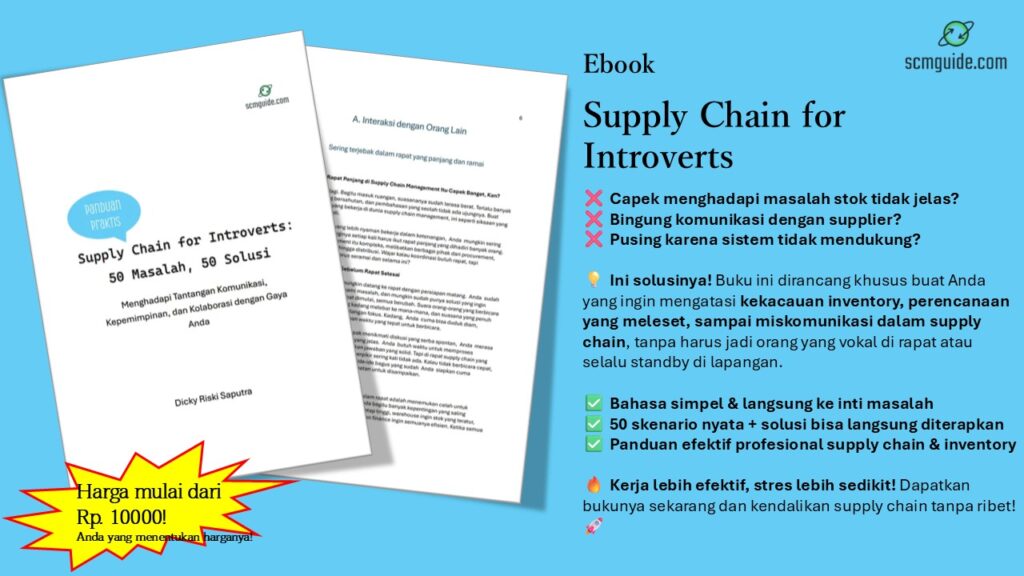In today’s competitive business world, especially in the supply chain, negotiation skills are crucial. You probably already understand that the supply chain is the heart of your operations—starting from sourcing raw materials, distributing products, to meeting customer demands. But have you really taken full advantage of every negotiation opportunity in your supply chain?
Many people think that everything in supply chain management is set in stone—prices, lead times, payment terms, and so on. However, if you know what’s negotiable, you can gain much more without sacrificing quality or operational efficiency. That said, not everything in the supply chain can be negotiated. Let’s explore what can be negotiated, the best times to do it, and why you don’t always have to say yes to everything your customers ask for.
Before we go further into this topic, don’t forget to follow my LinkedIn account. You’ll get more helpful insights on supply chain management there.
Table of Contents
What Can Be Negotiated in the Supply Chain?
First, it’s important to understand that the supply chain consists of many interconnected elements, some of which can—and often should—be negotiated. Here are some key areas where negotiation is commonly possible:
Price
The most obvious negotiable aspect is price. Suppliers usually offer a standard rate, but there is often room to lower prices, especially if you’re placing large orders or have a long-term relationship with the supplier. Negotiating price isn’t just about paying less—it’s about ensuring that the price you pay aligns with the quality and service level you expect.
Payment Terms
Payment terms offer another area for flexibility. Instead of paying upfront or in cash, you can negotiate net-30 or net-60 terms, allowing you to pay after receiving the goods. This can help your company better manage cash flow, especially during tight financial periods.
Lead Time
Delivery time is another factor that can be negotiated. If you need products or raw materials sooner than the standard time offered by your supplier, you can negotiate for express shipping at an additional cost or try to shorten the lead time without extra fees, particularly if you have a strong business relationship with them.
Minimum Order Quantity (MOQ)
MOQ can often be a challenge for smaller companies or when you only need a limited amount of stock. This is a great area for negotiation, especially if you want to trial a new product from a supplier or need smaller quantities for a specific period.
You might also like:
- PPIC: The Common Enemy in the World of Manufacturing
- Why Supply Chain Management is All About People
Shipping Costs
Shipping costs can also impact the profitability of your supply chain. If you work with several suppliers, there may be room to negotiate lower shipping costs, especially when you’re purchasing in large volumes regularly.
By recognizing these areas of negotiation, you can start identifying where your greatest opportunities lie in the supply chain. But remember, not everything can be negotiated. For example, safety standards, product quality, and government regulations typically aren’t up for discussion.
The Cost of Missing Negotiation Opportunities
When you fail to capitalize on negotiation opportunities in your supply chain, you could be leaving a lot of money on the table. Here are some potential downsides to not engaging in negotiation:
Higher Costs
Higher costs are the most immediate drawback. If you don’t negotiate prices, you may end up paying more than necessary. A little effort in negotiating could result in lower costs or more flexible payment terms, helping you save money and improve your profit margins.
Suboptimal Cash Flow
Without negotiating payment terms, you might find yourself tied to upfront or cash payments, which could strain your cash flow. This, in turn, affects your ability to reinvest in your business or take advantage of other opportunities because your funds are tied up in one transaction.
Limited Operational Flexibility
If you don’t negotiate lead times or MOQ, your operations could become less flexible. You might be forced to wait longer to receive materials, or you could end up overstocking just to meet a supplier’s MOQ requirement. This reduces your supply chain efficiency and could lead to excess inventory.
Weaker Business Relationships
Negotiation isn’t just about getting the better end of the deal. It’s also about building strong, mutually beneficial relationships. Suppliers and customers who feel valued in the negotiation process are more likely to be loyal and collaborate with you in the future.
By seizing every negotiation opportunity, you can create a more efficient, cost-effective, and flexible supply chain that will ultimately improve your company’s competitive edge.
You might also like:
- What Repeated Mistakes in Supply Chain Management Can Teach Us
- The Crucial Art of Job Allocation: Why It’s More Than Just a Numbers Game
Negotiating with Customers: You Don’t Have to Say Yes to Everything
It’s easy to fall into the trap of thinking “the customer is always right.” While it’s important to satisfy customer needs, giving in to every demand without careful consideration can harm your business in the long run. Negotiating with customers is just as important as negotiating with suppliers. Here’s why you don’t have to agree to every customer request:
Eroding Profit Margins
Customers may ask for deep discounts, highly flexible payment terms, or faster delivery times than you can realistically offer. If you always say yes without negotiating, your profit margins will shrink. It’s crucial to balance customer satisfaction with maintaining profitability.
Disrupted Operations
Some customer demands may force you to rearrange production schedules, overstock inventory, or expedite shipping at high costs. This not only affects your operations but can also disrupt the efficiency of your entire supply chain.
Fairness in Business Relationships
Offering preferential treatment to certain customers without considering the impact on your overall business can create an imbalance. If one customer gets a huge discount while others pay full price, it can create friction and damage your long-term relationships with other clients.
Negotiation Adds Value
Good negotiation leads to win-win solutions. Customers feel heard and valued, while your business can maintain profitability and efficiency. Through negotiation, you can also strengthen long-term relationships with customers, as they’ll see you as a partner committed to providing the best value.
Negotiating with customers doesn’t mean rejecting all their requests outright. It’s about finding solutions that benefit both parties without compromising your business’s financial and operational health.
Conclusion
Negotiation in the supply chain is a skill every business must master to stay competitive. By understanding what can be negotiated—such as price, payment terms, lead time, and shipping costs—you can maximize the efficiency and profitability of your business. At the same time, you need to be smart about managing customer demands. Not everything they ask for should be granted, and effective negotiation will ensure both sides benefit.
So, don’t miss out on negotiation opportunities. With the right strategy, you can build stronger relationships with suppliers and customers while maintaining operational stability and financial health. In the end, successful negotiation isn’t just about getting what you want—it’s about creating sustainable, long-term value for everyone involved.
I hope you find it helpful!
Please share this article with your colleagues so they can also benefit. For more insights on supply chain management, follow my LinkedIn account. You’re free to use all articles on this blog for any purpose, even for commercial use, without needing to give credit.

 by
by 


